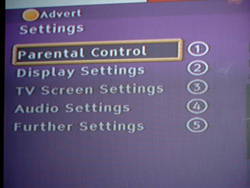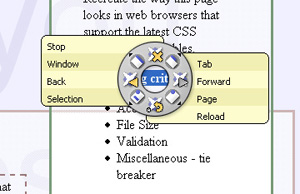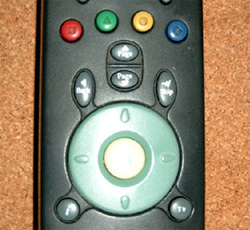Abstract
This document provides an overview of the pie menu concept, explains what a pie menu is and the advantages and disadvantages of pie menus in comparison with traditional linear menus. It was prepared as a byproduct of the development of a proof of concept device for digital television, as such the report focuses on the use of Pie Menus in this context.
What is a Pie Menu?
A pie menu is a method of offering a choice of menu options to an end user. Its fundamental goal is to serve the same purpose as traditional linear menus with which many people are familiar. The pie menu exists in a two dimensional environment, the screen, while traditional menus occur in the same environment they do not take advantage of the two dimensional nature, they present the menu options in a linear fashion.
The typical linear menu supplied by the set top box of a conventional system can be seen in the picture below.
This image demonstrates the one dimensional nature of current set top box menus.
Pie menus more fully embrace the two dimensional nature of the media they embrace. An example pie menu, taken from a screenshot of a web browser, can be seen in the image below.
This second image demonstrates how a pie menu segments its menu options into segments of circle. These pie segments are then arranged in their circle around the point of activation. To choose a menu option the user moves the selection device in the direction of the required option. Each option is the same distance from the selection “cursor” just the direction is different; therefore the quantative ease of selecting each menu option, using Fitts Law [1], will be the same.
What are the advantages of Pie menus?
To understand the advantages of pie menus in the set top box application we must first determine what those advantages are and explain the reasoning as to why they are an advantage.
- There is a uniform time and thus equal level of ease in selecting any menu option, according to Fitts Law [1].
- The directional nature of making menu choices using pie menus is better suited to use with variety of input devices, such as magic wands.
- The directional nature of input is also specifically suited to current remote control devices. The image below show the centre of a common remote control, the circular input device corresponds directly with the directional input needed to use pie menus, thus providing an intuitive interface to the menu.
- Repeated use of pie menus facilitates learning of menu options at a faster rate than using linear menus. The human body learns repeated muscular actions intuitively so the user can navigate menu options without having to explicitly learn the symbolic or textual labels of the menu choice.
What are its Disadvantages?
This part of the report introduces some of the disadvantages inherent in Pie menu based systems.
- The number of choices given by pie menus will not scale well above eight choices in a set top box system. This is due to the difficulty in associating label data with smaller pie segments as well as the increased difficulty in selecting segments using conventional control devices.
- Pie menus may take up more screen space on a display device due to the expansion over two dimensions.
- Many users will be unfamiliar with pie menus and may initially resist the concept.
Summary
After looking at both the disadvantages and advantages of pie menus it is important to relate the system to the needs of the users it will be satisfying and to support the interaction of the user with the system.
If devices such as the magic wand were used with this device then pie menus provide a clear advantage, as the pie menu only needs to locate the movement direction of the wand device, not the specific location on the screen, it is much easier for a user to select a menu option. This ease is due to the user not having to concentrate on the screen as much to obtain visual feedback on where the “cursor” is located.
The fact that pie menus do not scale as well above eight menu choices means that it is important that the design of the menus is well constructed to logically group together related menu functions into sub menus. Although this is a limitation it does help the design to conform to Millers assertion that seven menu items, plus or minus two, was the optimum number of items that could be processed by the average person [2]. Although this limit has been contested it is still a widely used measure in the design of human computer interfaces.
Given the proposed menu choices for the set top box system and the limit to three or four items per choice, the benefits gained by using pie menus outweigh the disadvantages outlined in this report.
References
- [1] Fitts, P.M. (1954). “The information capacity of the human motor system in controlling the amplitude of movement.” Journal of Experimental Psychology, vol. 47, p381-391
- [2] Miller, G.A. (1956), “The magical number seven, plus or minus two: Some limits on our capacity for processing information.” The Psychological Review, vol. 63, p81-97.
Further Reading
- The Design and Implementation of Pie Menus
- Mozilla Pie Menu Addition (As seen above)


